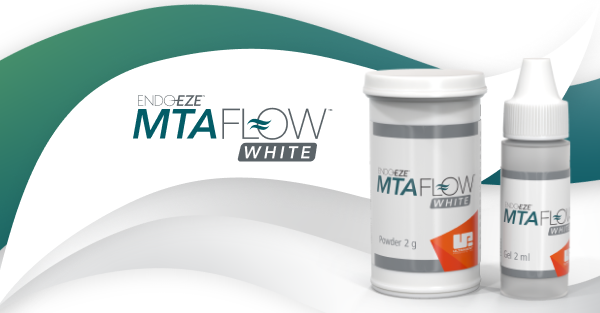Dentists have their own tool kits filled with specialised instruments to help with specific procedures. With financial strains and time constraints weighing on clinicians, finding tools that are versatile for a variety of clinical situations is more crucial than ever. Ultradent’s new MTAFlow™ White repair cement is that versatile endodontic tool.
Like its predecessor the original MTAFlow™ repair cement (already familiar to dentists), MTAFlow White repair cement kits consist of a powder and gel that clinicians mix themselves—giving dentists the power to achieve nearly any desired consistency for various endodontic procedures. This new formula is nonstaining—using Tantalum Oxide as the radiopacity agent for use anywhere in the tooth, especially in the esthetic zone.
This adaptability helps separate MTAFlow White repair cement from its competitors, according to Dr. Sonia Chopra, DDS. “I definitely don’t need so many different types of MTAs now,” she says of incorporating both of the MTAFlow repair cements into her practice. “I think I have one of each right now, so that versatility is really helpful.”
“MTAFlow repair cement is so versatile and you can use it in so many applications, it just makes sense to use it,” Chopra says. “For me, the main selling point for general dentists specifically, is that they can use it in so many different ways without splurging,” she adds of MTAFlow White repair cement’s cost.
Adaptability is at the core of Dr. Chopra’s experience. Her practice runs the gauntlet of procedures: dental fillings, root canals, tooth extractions, braces, dental implants, crowns and bridges, veneers, grafts, and I’m sure I’m leaving something out. Right now, she’s seeing a stressed need for endodontic work.
“We were seeing that people still really needed us,” she says of the early stages of the COVID-19 shutdown.
“We managed to be strategic with our schedules so we can socially distance, so we’ve had to change stuff around but we’ve still made it work.”
Dr. Chopra’s office never fully closed because tooth pain doesn’t care about quarantines. “We went down to three days a week, one doctor each day, just to make sure that we were getting people out of pain and keeping them out of the emergency room,” she says.
With office availability still limited in some areas, and some patients having postponed non-emergency procedures over the last year-and-a-half, general dentists may be experiencing increasing requests to tackle endodontic work. Using flexible products applicable for a variety of scenarios will help limit initial costs and provide stability. They’re essential for reacclimating to procedures that might not have been common in an office prior to the pandemic.
MTAFlow White repair cement being delivered with a NaviTip™ tip.
MTAFlow White repair cement comes in a kit. The two primary components are the powder and the gel (as dentists have seen with the original MTAFlow repair cement). The MTA powder is made through a proprietary process that refines it down to smaller than 10 microns. This fine powder—when mixed with the gel—provides very smooth cement that isn’t gritty or coarse.
The gel is also proprietary. When mixed with the MTA powder it creates a creamy, easy to deliver material. The gel is also equipped with an agent that helps accelerate setting time.
The mixing process is where the versatility of MTAFlow White repair cement shines.
“I can pretty much make whatever consistency I need to, so that definitely changes the application of it every time,” Chopra says. “Sometimes I’m fixing a furcal perforation and I don’t want the consistency to be runny because I want to pack. Because the perforation is so coronal, I can see it and pack it with ease, so I want a denser consistency. As opposed to resorption which could be anywhere in the root, and usually it’s down into the root, and in that case I want to keep my MTA a little more runny so I can deliver it all the way down there. A lot of times this is in the anterior region so I’m only going to use a white MTA in that area, so it’s nice to have that capability now.”
MTAFlow White repair cement can be mixed to be delivered via a 29 ga NaviTip™ tip, seen here.
Being able to customise consistency gives MTAFlow White repair cement unparalleled ease of placement—you can achieve a consistency so flowable that it can be delivered via a 29 ga NaviTip™ tip for various endodontic procedures, such as a following a root canal.
“That’s probably my favorite thing about it, because it is so easy and you can get so deep in the [root canals]. Whereas other vehicles to carry the material can be pretty bulky and the tips are really fat,” Chopra says. “If you’re not using a micro instrument, you’re not going to get as deep of a placement as you do with NaviTips.”
Basically, it all comes back to placement and versatility. With the new, nonstaining formula, MTAFlow White repair cement can be the reliable tool for clinicians’ endodontic needs.











